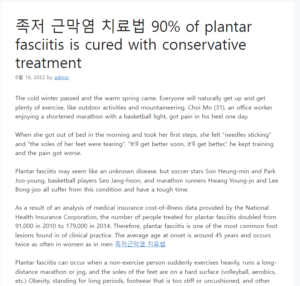The cold winter passed and the warm spring came. Everyone will naturally get up and get plenty of exercise, like outdoor activities and mountaineering. Choi Mo (31), an office worker enjoying a shortened marathon with a basketball light, got pain in his heel one day.
When she got out of bed in the morning and took her first steps, she felt “needles sticking” and “the soles of her feet were tearing”. “It’ll get better soon, it’ll get better,” he kept training and the pain got worse.
Plantar fasciitis may seem like an unknown disease, but soccer stars Son Heung-min and Park Joo-young, basketball players Seo Jang-hoon, and marathon runners Hwang Young-jo and Lee Bong-joo all suffer from this condition and have a tough time.
As a result of an analysis of medical insurance cost-of-illness data provided by the National Health Insurance Corporation, the number of people treated for plantar fasciitis doubled from 91,000 in 2010 to 179,000 in 2014. Therefore, plantar fasciitis is one of the most common foot lesions found in of clinical practice. The average age at onset is around 45 years and occurs twice as often in women as in men 족저근막염 치료법
Plantar fasciitis can occur when a non-exercise person suddenly exercises heavily, runs a long-distance marathon or jog, and the soles of the feet are on a hard surface (volleyball, aerobics, etc.) Obesity, standing for long periods, footwear that is too stiff or uncushioned, and other conditions that put undue stress on the plantar fascia often lead to inflammation. It can also accompany diabetics and arthritis patients. nicetomeetya
Greed is the first to try to force activities, the disease that gradually leads to plantar fasciitis (plantar fasciitis). Alternatively known as plantar fasciitis, the condition is known to be a serious condition that many fail to successfully manage, even with long-term treatment.
However, there is no need to worry as it is a disease that can be completely cured if the cause of the disease is understood and treated appropriately.
The pain may start at the heel of the foot and spread along the arch of the foot or be localized at the heel where the weight is concentrated. It usually occurs on one leg (70%), and in some cases walking further relieves symptoms.

The cause of plantar fasciitis is not clear, but people with strained Achilles tendons, people who stand or walk for long periods, people who are overweight, people who are flat, people who are the opposite of flat, and people with different leg lengths It occurs favorably people up.
In plantar fasciitis, overuse causes subtle damage to the fibers of the plantar fascia, and inflammation occurs in the damaged fascia, resulting in pain. Adequate rest is necessary for the injury to heal, but as it becomes chronic, the damage to the fascia becomes more severe and may progress to myofascial rupture, which can lead to degenerative degeneration of the injured tissue and impair tissue repair.
In the method of diagnosing plantar fasciitis, tenderness is observed in the medial area from the heel bone to the plantar arch, the Achilles cannon is strained, and the movement to raise the instep is difficult. Imaging can also be used for diagnosis, and bone poles can be observed at the heel bone in about 50% of patients with plantar fasciitis.
Ninety percent of patients with plantar fasciitis can be satisfactorily cured with conservative treatment. Since the disease itself is an overuse injury, rest is essential, and Onchimji, Cold Chimjil, and Achilles Gun Stretch are the most important.
People sometimes wonder why stretch your Achilles tendon when it’s plantar fasciitis that hurts. The reason is that when Achilles cannon tension persists, the flexibility to raise the ankle decreases and the attachment of the plantar fascia is strained when walking or running, aggravating the disease. Losing weight is also important if you are overweight.
Some patients do not like drug therapy, but it is better to take anti-inflammatory analgesics, as they are much more effective in treatment. Recently, extracorporeal shock waves (ESWT) have been known to be effective in the treatment of plantar fasciitis without any particular side effects and are used in many patients, including athletes. Although local steroid injections are excellent for short-term pain control, they do not affect the long-term course of treatment and are not recommended for long-term use.
Surgical treatment of plantar fasciitis is also possible in very rare cases if the disease does not improve after adequate conservative treatment for more than 6 months. Recently, the operation is performed with a minimal skin incision using an arthroscope without particular complications, and the results are relatively good.
Conditions that cause heel pain as opposed to plantar fasciitis include plantar fasciitis, stress fractures of the heel bone, fat pad syndrome, bursitis, degenerative osteoarthritis, tarsal tunnel syndrome, juvenile ankylosis, rheumatoid arthritis, burning rheumatoid arthritis in children, Sever’s disease, and even the spinal canal, a degenerative disease of the lower back Heel pain can be induced even with a stenosis.
Therefore, if long-term conservative treatment does not respond, it is important that, after consulting an orthopedist, an accurate diagnosis and treatment is provided before the disease worsens.
To prevent plantar fasciitis and prevent it from coming back, massage and stretch your calf muscles frequently to keep them from tightening and avoid hard-bottomed shoes or insoles. To relieve tension in the muscles of the soles of the feet, use a can or small plastic bottle to roll and massage the insides of the soles of the feet, preferably with movement.